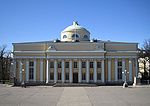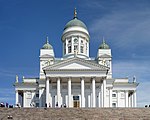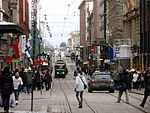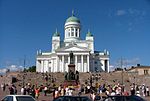Holy Trinity Church, Helsinki

The Holy Trinity Church (Finnish: Pyhän Kolminaisuuden kirkko, Swedish: Heliga Treenighetskyrkan, Russian: Свято-Троицкая церковь) is a Finnish Orthodox Church located in the Kruununhaka district of Helsinki, on the corner of Unioninkatu and Rauhankatu. The church was built in the neo-classical style in 1826 under the direction of the architect Carl Ludvig Engel, and was dedicated and opened in the following year. The Holy Trinity services the city's orthodox community with Divine Liturgy held in both Church Slavic and Finnish.The church is Helsinki's oldest Orthodox church. When Finland became 1808 autonomic Grand Duchy of Finland, a number of Russian civil servants, merchants and soldiers moved to Helsinki. They needed a place for worship, and the czar supported their efforts to get a church. In the 21st century, many of the churchgoers still speak Russian, but majority of them are immigrants born in the Soviet Union.
Excerpt from the Wikipedia article Holy Trinity Church, Helsinki (License: CC BY-SA 3.0, Authors, Images).Holy Trinity Church, Helsinki
Unioninkatu, Helsinki Kaisaniemi (Southern major district)
Geographical coordinates (GPS) Address External links Nearby Places Show on map
Geographical coordinates (GPS)
| Latitude | Longitude |
|---|---|
| N 60.171138888889 ° | E 24.951111111111 ° |
Address
Pyhän Kolminaisuuden kirkko
Unioninkatu 31
00170 Helsinki, Kaisaniemi (Southern major district)
Finland
Open on Google Maps








